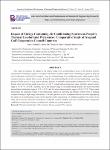Impact of Energy-Consuming Air Conditioning Systems on People's Thermal Comfort and Preferences: Comparative Study of Iraq and Gulf Cooperation Council Countries
| dc.contributor.author | Al-Hafith, O | |
| dc.contributor.author | B.K., S | |
| dc.contributor.author | De Wilde, P | |
| dc.contributor.author | Korsavi, S | |
| dc.date.accessioned | 2024-04-09T10:21:14Z | |
| dc.date.available | 2024-04-09T10:21:14Z | |
| dc.date.issued | 2024-03-25 | |
| dc.identifier.issn | 2630-5232 | |
| dc.identifier.issn | 2630-5232 | |
| dc.identifier.uri | https://pearl.plymouth.ac.uk/handle/10026.1/22257 | |
| dc.description.abstract |
This study investigates the impact of the intense usage of air-conditioning systems on the thermal comfort requirements of building occupants. It compares the thermal comfort requirements of building occupants in Iraq and Gulf Cooperation Council (GCC) countries. Iraqis have limited usage of air-conditioning units, whilst people in GCC countries intensely operate these systems. Research work underpinning this article involved undertaking a year-long thermal comfort survey in Iraq, and an intensive analysis of thermal comfort studies conducted in GCC countries. Results show that, in Iraq, people experience a 2–50 °C annual indoor temperature range, and their annual comfort range is 14–35 °C. In GCC countries, due to the intense usage of air-conditioning systems, the widest recorded annual indoor temperature range is 17.2–31.0 °C, and the widest annual comfort range is 20.0–27.8 °C. These results demonstrate the significant impact of air-conditioning systems on narrowing the thermal comfort limits of building occupants leading to high energy consumption. This study presents a novel comparison between two cases highlighting the impact of air-conditioning systems on the thermal comfort requirements of building occupants. The results of this study can be used to inform the development of thermal comfort standards that better consider people’s adaptation capabilities to help reduce energy consumption for heating and cooling purposes. | |
| dc.format.extent | 1-19 | |
| dc.publisher | Bilingual Publishing Group | |
| dc.subject | 33 Built Environment and Design | |
| dc.subject | 3301 Architecture | |
| dc.title | Impact of Energy-Consuming Air Conditioning Systems on People's Thermal Comfort and Preferences: Comparative Study of Iraq and Gulf Cooperation Council Countries | |
| dc.type | journal-article | |
| plymouth.issue | 1 | |
| plymouth.volume | 7 | |
| plymouth.publisher-url | http://dx.doi.org/10.30564/jaeser.v7i1.6220 | |
| plymouth.publication-status | Published online | |
| plymouth.journal | Journal of Architectural Environment & Structural Engineering Research | |
| dc.identifier.doi | 10.30564/jaeser.v7i1.6220 | |
| plymouth.organisational-group | |Plymouth | |
| plymouth.organisational-group | |Plymouth|Faculty of Arts, Humanities and Business | |
| plymouth.organisational-group | |Plymouth|Faculty of Arts, Humanities and Business|School of Art, Design and Architecture | |
| plymouth.organisational-group | |Plymouth|REF 2021 Researchers by UoA | |
| plymouth.organisational-group | |Plymouth|Users by role | |
| plymouth.organisational-group | |Plymouth|Users by role|Current Academic staff | |
| plymouth.organisational-group | |Plymouth|REF 2021 Researchers by UoA|UoA13 Architecture, Built Environment and Planning | |
| plymouth.organisational-group | |Plymouth|REF 2029 Researchers by UoA | |
| plymouth.organisational-group | |Plymouth|REF 2029 Researchers by UoA|UoA13 Architecture, Built Environment and Planning | |
| dcterms.dateAccepted | 2024-02-22 | |
| dc.date.updated | 2024-04-09T10:21:13Z | |
| dc.rights.embargodate | 2024-4-10 | |
| dc.identifier.eissn | 2630-5232 | |
| dc.rights.embargoperiod | ||
| rioxxterms.versionofrecord | 10.30564/jaeser.v7i1.6220 |


